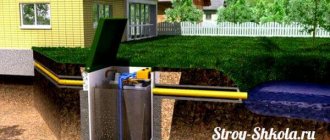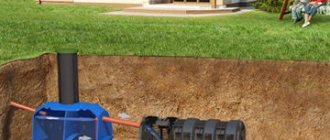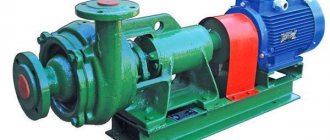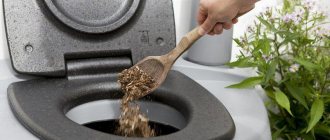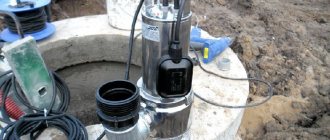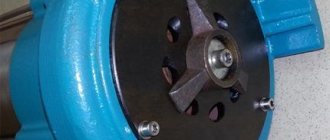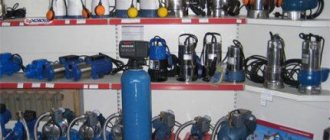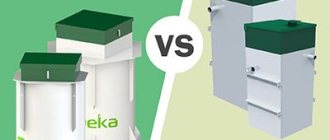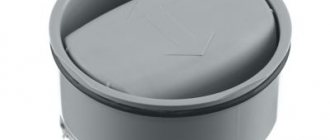Our customers very often ask: which septic tank is better to buy for their dacha? In this article we will understand what septic tanks are, what they are like and for what conditions they are suitable. And, of course, we will answer the question: which septic tank is better for a dacha?
A septic tank is a sealed container divided by partitions into several compartments. Mechanical settling of domestic wastewater and fermentation occurs in each compartment. As a result, the wastewater is clarified and, to some extent, purified from organic impurities. A septic tank allows you to make a comfortable toilet in your dacha and install plumbing for a comfortable life (bathtub, dishwasher, washing machine).
Advantages of septic tanks:
- They have a simple design. There is no electrical equipment, except when drainage is made through a biofilter and through a well with a pump. The risk of breakdown and unexpected expenses is minimal.
- They do not need to be serviced frequently. A sludge sucker is called in for pumping once a year.
- They are inexpensive. This is the cheapest treatment facility for dachas.
Disadvantages of septic tanks:
- The runoff is only 50-60% purified and cannot be discharged onto open ground. You need a filtration field or a drainage well, and they can only be done in dry filter soil.
- The price of installing a turnkey septic tank is higher than the price of the tank itself.
- There may be a smell. It is recommended that the vent pipe be installed on the roof of the building.
Septic tanks for dachas with high groundwater and/or clay soil
Clients are interested in whether septic tanks are suitable for dachas with high groundwater. We don't recommend them for 2 reasons:
- Clay does not allow water to pass through. The water stagnates in the filtration field and flows back into the septic tank.
- In high groundwater, the container may float. The filtration field or well becomes flooded and does not work.
You have difficult soil at your dacha, but have you decided to install a septic tank? There are 2 options:
1. Sand and gravel filter (on clay).
A trench is made between the septic tank and the well, filled with crushed stone. Perforated pipes are laid in the crushed stone layer. Part of the water is absorbed into the ground through the perforation, and part is discharged into a storage well and pumped out into the ditch.
2. Factory biofilter.
For example, the Rostock biofilter (discussed below) with discharge into a storage well and then into a ditch. Water can be used to water non-fruitful plants in the country.
Both methods greatly increase the cost of installation. In addition, the biofilter needs to change the load every few years. We usually do not install such a system at our dachas. With turnkey installation, it is more expensive than a biorefinery station.
Below we will look at septic tanks:
- Made of concrete.
- Made of polyethylene (Rostock, Termite);
- Made of fiberglass (Flotenk STA, Baikal);
- Made from polypropylene (Eurolos Eco).
Polyethylene septic tanks for summer cottages
The cheapest and therefore the most popular for summer cottages. They are made from polyethylene using rotational molding technology. Polyethylene granules are poured into a collapsible mold. It is rotated and heated. The granulate melts and spreads evenly over the mold, forming a hollow, seamless container.
How rotational molding is performed (picture below)
Advantages of polyethylene settling tanks:
- One-piece construction, leak-proof.
- Low price.
- Light weight.
Disadvantages of polyethylene septic tanks for summer cottages:
- Plastic material subject to compression.
- During installation, you need to sprinkle the DSP. These are unnecessary expenses.
These treatment plants are suitable for sandy and sandy loam soils and low groundwater levels. We do not recommend installing such a septic tank with a biofilter in clay or at high groundwater levels. The sprout can be considered an exception, since it has a cylindrical shape that is optimal for difficult soil.
Septic tank Termite
Has a one-piece polyethylene body. Wall thickness – up to 20 mm. The drain settles in all chambers, undergoes anaerobic treatment (fermentation) and is discharged into a drainage well or filtration field. The last chamber contains a bioload for fixing microflora and reducing the removal of sludge during volley discharges.
The manufacturer also offers the Termite Transformer septic tank for summer cottages. It can be easily converted into an Ergobox biotreatment station. To do this, an aerator, compressor and pump are installed in it. Convenient if the conditions at the dacha have changed and you need to make a forced diversion. Treated wastewater can be discharged into a roadside ditch without further treatment.
Advantages of the Termite septic tank:
- Molded body, no seams.
- Synthetic bioload for fixing microflora and better cleaning.
- Low price.
Disadvantages of the Termite septic tank:
- Rectangular body shape. The soil presses unevenly, the walls can dent.
- The manufacturer does not provide a warranty for the treatment plant.
- During installation, they are covered with a cement-sand mixture. DSP is more expensive than sand.
Tver is the best autonomous sewerage system for year-round use
When arranging an autonomous sewer system, many residents are interested in which septic tank is best for a summer house, country house, cafe, hotel, shopping center. The manufacturer of wastewater treatment plants Tver offers 44 models that provide biological treatment of wastewater with a volume of 0.35 - 200 m3/day; the following classification will help simplify the choice of design as much as possible:
- Basic models are designed for permanent/temporary use by 2 - 30 people.
- Special septic tanks make it possible to combine groups of buildings and structures accommodating more than 1,500 users.
Special conditions for installation and operation of the septic tank are indicated by the following marking:
P - polypropylene devices that place inlet pipes at a depth of 30 cm from the soil level. Water drainage is gravity.
PN – structures equipped with a pumping system for forced removal of liquid media.
PM are modified septic tanks made using the “fin extension” technology, which allows increasing the insertion depth of the pipes - 60...100 cm.
NP is a model supplemented with a chamber for a fecal pump with metal stiffeners. The inlet pipe is placed at a height of 110 - 140 cm.
NPN - septic tanks for summer cottages with 2 pump compartments for fecal pumps.
The presented septic tank options allow you to install pumping equipment and increase the neck; the cost of the service will cost 3,000 rubles/10 cm.
Advantages of a septic tank Tver:
- Possibility of self-installation (in the “quicksand” when a high groundwater level is reached), maintenance - 2 times a year.
- Versatility of use due to the absence of narrow passages and meshes subject to clogging.
- Reliability of Russian-made design (50 years).
- No additional investments. The full cleaning cycle takes place inside the structure.
- Energy independence, allowing for uninterrupted operation of a septic tank at a dacha or country house in Moscow, St. Petersburg and regions of the Russian Federation. The maximum period of uninterrupted operation is 2-3 days.
- No unpleasant odors.
- The septic tank body is made of reinforced polypropylene, providing a high level of corrosion resistance.
- The maximum degree of purification (97-98%) is achieved by gravitational, anaerobic, biological processing of liquid inside the device. The last option is achieved in chambers 3-5. Thanks to the correct arrangement of the overflow system, moving water between chambers does not require the installation of pumping systems.
- Eliminates the need to create filter fields. Tver septic tank processing products meet sanitary requirements. Treated wastewater must be disposed of in reservoirs, canals, and soil.
- By selecting a septic tank that meets operating conditions, users receive a 100% guarantee that there will be no malfunctions in the event of sudden discharges of wastewater, for example, draining a bathtub or swimming pool. The maximum volume of a single discharge is 500 liters.
- A special partition that retains the sediment of heavy impurities eliminates the need for regular replacement of cleaning filters.
- Septic tanks that go on sale contain self-regenerating bacteria, which is enough for the entire service life.
- The manufacturer of the septic tank Tver recommends installing the compressor indoors, helping to increase the performance of the device.
- Large polypropylene sewer hatches provide easy access to cleaning the structure.
- A light weight. The design allows installation work to be carried out without special equipment. There is no need to concrete or insulate the installation. Installation depth 1.8 - 2 m.
Catalog and prices:
Tver-0.35 - wastewater volume 350 l/day, weight 90 kg, dimensions 140x110x172 cm, price 64,900 rubles.
Tver-0.5 - 500 l/day, 100 kg, 165×110×167 cm, 72,000 rubles.
Tver-0.75 - 750 l/day, 120 kg, 225x86x172/190x110x172 cm, 82,900 rubles.
Tver-0.85 - 850 l/day, 130 kg, 210x110x172 cm, 89,800 rubles.
Tver-1 - 1000 l/day, 150 kg, 250×110×172 cm, 102,800 rubles.
Tver-1.2 - 1200 l/day, 200 kg, 280x110x172 cm, 111,000 rubles.
Tver-1.5 - 1500 l/day, 250 kg, 350×110×167 cm, 125,000 rubles.
Tver-2 - 2000 l/day, 310 kg, 400×130×172 cm, 156,900 rubles.
Tver-3 - 3000 l/day, 310 kg, 400×160×172 cm, m, 176,900 rubles.
Tver-4 - 4,000 l/day, 620 kg, 400×130×172 cm, 292,900 rubles.
Tver-4.5 - 4,500 l/day, 650kg, 380×190 cm, 313,200 rub.
Tver-6 - 6000 l/day, 700 kg, 400×160×172 cm, 349,800 rubles.
Tver 10 - 10,000 l/day, 6000 kg, 720xØ190 cm, 489,000 rubles.
More about the septic tank Tver
Septic tank Rostock
Case material – polyethylene. The middle chamber is a vertical “glass”. The runoff enters through inclined overflows into the lower part of the chamber and through a filter between the chambers seeps into the upper part. The filter traps large debris. Clarified water is discharged into a well or onto a filtration field.
Pros:
- The body is cylindrical, resistant to compression.
- The overflow design allows large debris to be retained.
- If the soil is filtering and/or the neck is not elongated, then the filling is done with sand. This makes installation cheaper.
- The manufacturer provides a warranty of 1 year from the date of sale.
Minuses:
- The neck is welded to the body. Now the manufacturer is changing the design so that the neck is integral with the body. The sprout will become more reliable.
- The manufacturer recommends anchoring Rostok even at low groundwater levels (a special anchoring kit is offered).
- Relatively high price (more expensive than Termite and Tank).
If the fan pipe lies deep, then you can increase the necks by 640 mm or 940 mm (only for Rostock Mini, Dachny and Zagorodny). A sprout with elongated necks is buried deeper. In this case, the soil pressure is greater and the filling is done with a cement-sand mixture in a ratio of 5:1.
In Rostok Dachnoye, Zagorodnoye and Cottage, an additional pump compartment can be installed to remove wastewater. This allows you to save on installing a storage well with a pump.
Fiberglass septic tanks for summer cottages
Fiberglass threads (roving) are impregnated with synthetic resin and wound on a cylindrical mandrel. Winding is done manually or by machine. The case turns out to be very durable. Sidewalls, necks and pipes are made separately and molded to the shell (cylindrical base). If the molding is done poorly, leaks will appear.
How to wind glass fiber by machine (picture below)
Advantages of fiberglass septic tanks for summer cottages:
- Rigid material that can withstand strong soil pressure. You can bury it deeper if the drain pipe is brought out deep.
- The body is cylindrical, the load is distributed evenly.
A fiberglass septic tank can be installed at great depths thanks to its rigid body. This is an important advantage, since the drain pipe is often located deep in the house.
Disadvantages of fiberglass septic tanks:
- The sides and necks are molded by hand. Possible manufacturing defect.
- Expensive due to complex technology and cost of materials.
- There is no pumping chamber or additional equipment. Installation in clay and at high groundwater levels is expensive
Autonomous sewage system Unilos Astra
The Astra septic tank is a functional installation that provides the technological process of wastewater treatment inside a sealed housing. The septic tank is suitable for cleaning wastewater from the kitchen, bath, toilet, jacuzzi, swimming pool, where effective disposal of liquid household waste is required. The manufacturer confirms the annual certification of the product in accordance with ISO 9001:2008 standards.
The choice of the Astra septic tank model for a summer house or country house is determined by a number of criteria:
- The amount of daily water consumption. Before purchasing a household structure, you should determine what is the generally accepted norm for one user (200 l), and multiply by the number of users. The result obtained will allow you to choose the right septic tank for your dacha, country house, cottage, or non-residential property.
- Type of soil. The soil has a high throughput capacity and does not require the use of pumps for forced drainage of liquid into a storage tank. Placing a septic tank in clayey and loamy areas requires connecting a built-in storage tank and pump (preliminarily determine which pump model to choose for a specific station).
- The need for further use of purified water. To improve the hygienic characteristics of water, the manufacturer suggests using additional equipment that disinfects wastewater with ultraviolet and ultrasonic action.
- The depth of the underwater pipe (when choosing a septic tank, you should take into account what height of the supply pipes is suitable for the “Standard”, “Midi”, “Long” series - 80 cm, 1 m, 1.5 m).
Advantages of Unilos Astra septic tanks:
- degree of purification of waste products - 95%;
- manufacturer's warranty - 10 years;
- completely sealed and waterproof;
- maintaining an optimal temperature regime for the liquid (+15…+17°C), eliminating the possibility of water freezing at the outlet into the filtration fields or storage tank;
- possibility of operation in difficult climatic conditions, in earthquake-prone areas;
- aeration processes provided by air filters neutralize unpleasant odors;
- the Astra septic tank consumes a small amount of electrical energy (which is especially beneficial for dachas);
- the aerobic system does not require the creation of post-treatment filters.
Below you can find out what prices are offered by the manufacturer of septic tanks Unilos Astra:
Astra-3 is a treatment facility that accepts a daily discharge of 0.6 m3, electricity consumption 0.06 kW/h, weight 140 kg, dimensions 820x1000x2000 mm, cost 58,900 rubles.
Astra-5 - 1 m3, 0.06 kW/h, 230 kg, 1040x1000x2360 mm, 71,200 rubles.
Astra-8 - 1.6 m3, 0.08 kW/h, 290 kg, 1500x1040x2360 mm,
89,590 rubles.
Astra-10 - 2 m3, 0.1 kW/h, 365 kg, 2000x1040x2360 mm, 107,900 rubles.
More information about the Astra septic tank
Septic tank Flotenk STA
Consists of three settling chambers. The design is simpler than that of Rostok and Termite. No synthetic loading. Overflows without any technical features. The main advantage is a rigid body that will definitely not be crushed by the ground. Manufacturer: Flotenk plant. This is a company with extensive experience that you can trust.
Flotenk-STA device (picture below)
Advantages of Flotenk-STA:
- Painting in resin. Stable color.
- The necks come separately and are connected during installation through existing rubber cuffs. Thanks to this, the Flotenk is more convenient to transport and install at the required depth.
- Sprinkling during installation is done with sand. This is cheaper than sprinkling DSP.
- Anchoring is only necessary when the groundwater level is high or in clay.
- Manufacturer's warranty – 2 years.
Disadvantages of Flotenk-STA:
- Leaks may occur at the connection points of the necks and pipes.
- High price.
The principle of operation of septic structures
A septic tank is a structure designed to treat wastewater. The design of its device assumes the presence of a multi-chamber system. Wastewater flows into the first tank through a pipeline from the house. This is a septic tank. It undergoes bacterial decomposition of wastewater. In some devices, most often industrial ones, special structures are installed here that perform primary filtration of contaminated water. Decomposition of wastewater occurs under the influence of oxygen-free or anaerobic bacteria. They convert the liquid entering the settling tank into clarified water, gas and mineral insoluble sediment or sludge.
All anaerobic septic tanks consist of several chambers. In the first, primary wastewater treatment and partial filtration occur. In the second and subsequent stages, the purification process continues.
The gas formed as a result of the decomposition of wastewater is removed using a ventilation pipe, while the water goes through the overflow hole into the second tank. Here, anaerobic bacteria continue to clean the wastewater. From here, clarified water can flow into the next container or be supplied to the so-called filtration fields. After soil filtration, clean liquid is absorbed into the soil. Such structures are classified as energy-independent or anaerobic systems.
There is also a type of device that requires electricity to operate. These are aerobic septic tanks with a biological treatment system. Wastewater treatment in such devices is carried out by aerobic microorganisms that cannot exist without oxygen. Therefore, the compressor, which automatically turns on at certain intervals, supplies air inside the tanks. The process of wastewater decomposition in such installations occurs as quickly as possible. The degree of purification of contaminated water reaches 98%.
For an aerobic septic tank to operate, a constant flow of oxygen is required, since the bacteria contained in the activated sludge die without it, and the cleaning process stops
One of the simplest structures is a storage septic tank. This is a single-chamber sealed device designed to accumulate wastewater, which is subsequently pumped out using a sewage disposal machine. The tank is additionally equipped with a tank filling level sensor. This option is optimal for those who rarely appear in their country house, and also if, for various reasons, it is impossible to equip an effective wastewater treatment area.
Septic tank Baikal
Manufacturer: Baikal LLC, Gatchina district of the Leningrad region. The technology is machine winding of roving, just like Flotenok. The company has been on the market for many years, its products are well-known and in demand.
Advantages of the Baikal septic tank:
- Cylindrical body, resistant to soil pressure.
- Reinforcement with stiffening ribs.
- The design of the overflows allows the film to be retained.
- It is necessary to anchor only in clayey soil and when groundwater is high.
- You can quickly increase necklines.
- Sprinkling with sand, not DSP.
- Competitive price.
Disadvantages of the Baikal septic tank:
- They may be leaky due to poor-quality molding (the same problem as with Flotenk-STA septic tanks).
Video description
Biological sewage treatment stations for non-permanent residences have their own conservation process for the winter period. Everything is clearly shown in the video:
Metal septic tanks
Polymer septic tanks have replaced metal containers, but they are still found. Among the offers on the metal septic tank market there are three types of containers:
- factory products with fixed characteristics;
- production to order according to individual sizes;
- sale of used steel tanks and containers for technical liquids, which are modified for storage septic tanks.
Unlike polymer ones, such containers have a large margin of safety: the minimum metal thickness is 4 mm, and for large-volume containers - 8-12 mm. But the service life of metal septic tanks at summer cottages, even with anti-corrosion treatment, is lower than that of plastic ones.
Polypropylene septic tanks for summer cottages
Quite rare due to the high cost of the material. Eurolos is one of the few companies producing polypropylene septic tanks. Eurolos Udacha is a septic tank for the most minimal needs (seasonal residence, minimum users). Eurolos ECO has a larger volume. It is suitable for both permanent and seasonal residence in the country. This septic tank is designed for 3-20 people, depending on the model.
Advantages of polypropylene septic tanks for summer cottages:
- Rigid material, resistant to compression.
- The sides, partitions and necks are welded rather than molded, the body is sealed.
- No anchoring required.
Disadvantages of polypropylene septic tanks:
- Not very common, choice of brands is limited;
- Welds may not withstand pressure. It is important not to leave the device empty after pumping
Septic tank Eurolos ECO
The body is made of homogeneous polypropylene. In the middle chamber there is a bioload on which colonies of microorganisms are formed. This prevents the leaching of microflora and makes it less sensitive to the composition of the wastewater.
Advantages of Eurolos Eco:
- Cylindrical body made of durable material.
- Welded connections, the housing is sealed from the factory.
- Ruff loading. Less sludge is washed out, and the quality of cleaning is stable.
- Large necks. Useful when you need to determine the water level.
Disadvantages of Eurolos Eco:
- There are no water seals; floating impurities are less well retained during overflows, as in Flotenk STA and Baikal septic tanks.
- Once every 2-3 years you need to change the load.
So, we can answer the question, which septic tank is better for a dacha:
- In case of high groundwater and clayey soil, it is better to install Eurolos ECO and other settling tanks made of polypropylene.
- In dry sandy soil and low groundwater level, you can install septic tanks made of Rostock or Termit polyethylene.
- For any soil and when the pipeline is deep, fiberglass septic tanks Baikal or Flotenk STA are suitable. They can be buried at great depths and will withstand soil pressure.
The managers of the Zagorod company, as well as our measuring engineer, will help you choose a septic tank for your dacha. He will visit your dacha before installation and determine the conditions in which the sewage system will operate (what kind of soil, how high is the groundwater). If conditions permit, the engineer will advise you on a suitable septic tank. If the conditions are difficult (clay, high groundwater level), then he will recommend a biotreatment station.
Local system selection options
Before deciding on the type of autonomous sewer system to be installed, it is necessary to take into account certain factors, including:
- the terrain of the site - whether there is a slope on it, in which direction it is directed;
- what kind of soil - its density, type, structure;
- climatic features - how deep the soil freezes in winter;
- size of the territory - how much space can be allocated for installing the system;
- number of residents and volume of water consumed (which septic tank to choose for a private home).
There are several types of septic tanks , and the choice of a specific one should be based on an analysis of the above factors.
The price of a septic tank for a turnkey cottage
The main question for all customers is the price of the treatment plant and its installation at the dacha. You will find the prices of Rostock and Termite septic tanks in our catalog. They depend:
- From volume and productivity;
- From the material from which the body is made. Polyethylene septic tanks are the cheapest, fiberglass ones are more expensive, and polypropylene ones are the most expensive.
In ascending order of price, you can arrange the treatment plants as follows: Tank, Termit, Rostok, Baikal, Flotenk STA, Eurolos Eco.
The cost of installation depends on its complexity:
- The usual situation is that the soil at the dacha is clayey and the groundwater is high. In this case, a sump tank with a biofilter and a storage well is installed. If the area is dry and the soil is sandy, then a drainage well or filtration field is installed. Installing a system with a biofilter is more difficult and expensive.
- Additional work may be required (reworking the fan pipe or extending the necks). These works are agreed upon in advance and paid separately. If there is quicksand in the pit, then the installers make formwork. If boulders are found, an excavator is hired. These features are not determined by measurement.
Bioxy 1
In this type of septic tank for a private home, the processor uses membrane blowers. There is a control unit for automatic washing. Standard electrical products sold in any construction store are used.
The container for a clean system is already present; there is no need to purchase it in addition. The treatment station is controlled by a timer (the standard is set to 30 seconds).
Average consumption is about 45 watts (economical).
Installation of a septic tank for a country house on a turnkey basis in the Zagorod company:
- Departure of a measuring engineer to the site. At this stage, a location for the septic tank is selected taking into account sanitary requirements, the depth of the inlet pipe and the slope of the supply pipe (20 mm per meter). The surveyor draws an installation diagram, the customer receives a detailed estimate with the total amount.
- Delivery of materials and components to the dacha on the day of installation.
- Digging a pit.
- Pouring a concrete slab in the pit and anchoring with stainless steel cables*.
- Sprinkling with cement-sand mixture** or sand and filling with water.
- Laying inlet and outlet pipelines.
- Construction of a filtration field or drainage well.
- Final backfill.
*When installing in a country house with low groundwater, anchoring is not necessary. It is important to follow the operating rule - do not leave the container empty after pumping, so that it does not float up.
**The optimal ratio of sand and cement is usually indicated by the manufacturer in the data sheet.
Useful tips and nuances when purchasing
Once you understand how to choose the right septic system, you should listen to useful advice from professionals. First, it is best to choose equipment that requires minimal maintenance.
Many septic stations with biological treatment require maintenance by the owners themselves.
The simpler the system is and the less it needs control and intervention, the easier the life of its owners will be. The ideal option is when the owner of the dacha himself can perform all the necessary manipulations with the cleaning installation.
Secondly, you should try to choose energy independence. Many owners of permanent residences, having settled on dependent models, immediately take care of generators and spare batteries.
After all, such foresight will be needed not only for the functioning of the sewer system, but also for other consumers of electricity - microwaves, televisions, computers and other equipment.
Unfortunately, some summer residents do not think about groundwater pollution, installing a absorption well on their summer cottage instead of a local sewerage system
A filtration (also known as absorption or absorption) well is designed for ground-based post-treatment of wastewater treated in a septic tank.
As an independent structure, it can serve to receive and filter gray sewage - water contaminated during hygiene procedures, during cleaning, working in the kitchen, coming from dishwashers and washing machines.
Thirdly, you should try to organize the discharge of treated wastewater into the ground, and not onto the terrain. Otherwise, the exiting liquid must be purified by 98% so as not to create an environmental disaster at the site.
After all, untreated pollution can not only contaminate groundwater - it will create an unbearable stench throughout the entire area.
To organize filtering fields, there are certain rules and recommendations that you should follow
Fourthly, the service life of the selected septic tank must be equal to the service life of the house itself. This is at least 50-80 years. Accordingly, it is better to immediately discard a metal container as a storage device.
You can focus on other materials - they can last 50 years or more without corroding.
No matter how high-quality the anti-corrosion coating is, it will not last 50 years. This is fraught with big problems for the owner of a metal septic tank
Fifthly, you should take seriously the choice of installation location for the future cleaning system. Here it would be useful to focus on the standards and sanitary requirements for sewerage equipment.
Also, each septic tank has its own recommendations, set out in the corresponding instructions. It is on them that you should rely during installation.
Sixth, you need to read reviews about the septic tank you like on independent resources, for example, on construction forums. When studying all the information about it, you should rely on serious regulatory literature, and not on advertising.
Seventh, having settled on the option of purchasing a station, it is more advisable to immediately order installation. After all, its trouble-free functioning depends on proper installation.
It is worth remembering that the purchased septic equipment can perform its functions efficiently for at least 50 years. It is better not to skimp on its installation in order to avoid negative consequences from mistakes.
A properly installed septic tank will not only not interfere with everyday life, but will also save its owner from sudden breakdowns and failure of the sewer system
